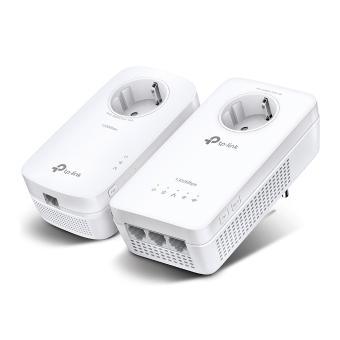How to secure (pair) the Powerline Network
What is Powerline?
Powerline products turn the electrical wiring of a home into network cables and transmit signals to every room. You can form a Powerline network wherever there are power outlets, eliminating the need for expensive and complicated Ethernet cables.
To form a basic Powerline network, it must be deployed in a set of two or more and be connected to the same electrical circuit whether wired or wireless ones.
Note: The models begin with TL-WPAxxxx will broadcast the Wi-Fi signal (“W” for “Wireless”); The models start with TL-PAxxxx only support the Ethernet connection.
Here we take TL-WPA8630P KIT as a demonstration:

LED explanation (TL-WPA8630P as an example) for reference:


How to Set Up the Powerline Network?
Powerline adapters are simply plug-and-play devices, so please plug both Powerline units into the wall sockets in the same room. Wait 2-3 minutes, when the Powerline LED turns on, connect the Powerline adapter to your router’s LAN port via an Ethernet cable, then relocate the other Powerline adapter to a new location and enjoy the new extended network.
If the Powerline adapters cannot pair automatically with each other, please follow the steps below.
If it is not the first time you install the Powerline adapters, please reset them to default settings to set up.
How to Reset the Powerline Adapter to Factory Default?
Step 1: Power on the Powerline adapters.
Plug the Powerline extender into a wall socket near one of the existing Powerline adapters.
Note: We recommend that you plug in your Powerline devices as close to each other as possible when pairing. Then relocated to where they are needed once pairing is complete.
One Powerline adapter is required to connect to the router via an Ethernet cable.
Step 2: Pair the Powerline adapters.
a. Press and hold the Pair button for one second on the Powerline Adapter. Then the Power light will be blinking quickly.
Note: If the Power light is not blinking, please press the pair button for a longer time.
Physical Interface:



For more details, please refer to the Quick Installation Guide or User Guide.
b. Within 2 minutes, press and hold the Pair button on another Powerline Extender for one second. Then the Power lights on both Powerline devices will be blinking quickly at the same time.
c. When the Powerline LED turns on, the new device has been successfully added to your Powerline network.
Notes:
1. For TL-PA201/TL-PA211 V1/TL-PA210 V1/TL-PA251 V1, you need to hold the Pair button 3-8 seconds to start the pairing procedure.
2. If you want to add more adapters, please press the pair button on one of the existing networks, then press the Pair button on the adapter which wants to be joined in the existing network. Simply add them one by one as the instruction above.
Step 3: Relocate the Powerline adapters.
After the powerline lights on both Powerline adapters are all lit up, please connect one Powerline adapter to the router via an Ethernet cable and another one plug into the desired place.
Note:
1. If the Powerline light is red, it means the powerline adapter is experiencing poor signal strength. Try plugging it into another wall socket.
2. If you have a Powerline Extender, the default Wi-Fi name and password are printed on the Wi-Fi Info Card and device’s bottom label.
Step 4: Connect the device to the Powerline adapters and enjoy the internet.
If you want to change the Wi-Fi name of the Powerline Extender, please refer to How to Change Wireless Setting Using the tpPLC App (Smartphone)?
Questa faq è utile?
Your feedback helps improve this site.


3.0_1532428956469j.jpg)